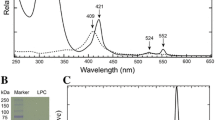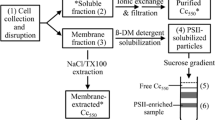Abstract
The b and c-type cytochromes present in cytoplasmic membranes of Proteus mirabilis, which had been grown under different conditions, were characterized by means of analysis of 77K spectra monitored at different oxidation-reduction potentials.
After aerobic growth as well as after anaerobic growth in the presence and absence of nitrate one or more high midpoint potential b-type cytochromes were found (E′0 approx. 150 mV). Especially after aerobic growth the contribution of this cytochrome (these cytochromes) to the absorbance in the 535–575 nm region of 77K spectra was very large (63%). 29% could be attributed to an a-band at about 563 nm and 34% to an a-band at 556 nm. After anaerobic growth in the presence of nitrate the high potential cytochrome(s) yielded a-bands at about 561 nm (7%) and 556 nm (31%) and after anaerobic growth in the absence of a terminal electron acceptor a-bands were found at about 560 nm (26%) and 555 nm (13%).
b-Type cytochromes with midpoint potentials between 10 and 50 mV were found after both aerobic- and anaerobic growth conditions. Especially after anaerobic growth in the presence of nitrate the contribution of a cytochrome b-556 (E′0 =24 mV) to the absorbance band between 535 and 575 nm was very large (57%). After aerobic growth the contribution of cytochrome b-557 (E′0=49 mV) was 22%, while after anaerobic growth in the absence of a terminal electron acceptor the contribution of cytochrome b-557 (E′0=10 mV) was only 14%.
Low potential b-type cytochromes were especially found after anaerobic growth in the absence of a terminal electron acceptor; 21% cytochrome b-556 (E′0=-121 mV) and 19% cytochrome b-557 (E′0=-242 mV). After aerobic growth 14% cytochrome b-556 was found with a midpoint potential of about-106 mV.
A small percentage cytochrome c (μm about 548–549 nm) was found in the three types of cells. Its midpoint potential was about 75 mV.
Similar content being viewed by others
Abbreviations
- Hepes:
-
4-(-2-hydroxyethyl)-1-piperazineethanesulphonic acid
- TMPD:
-
N,N,N′,N′-tetramethyl-p-phenylenediamine
References
Beek van der EG (1976) Oxidative phosphorylation and electron transport in Proteus mirabilis. Ph. D. Thesis, Vrije Universiteit, Amsterdam, The Netherlands
Beek van der EG, Oltmann LF, Stouthamer AH (1976) Fumarate reduction in Proteus mirabilis. Arch Microbiol 110:195–206
Enoch HG, Lester RL (1974) The role of a novel cytochrome b-containing nitrate reductase and quinone in the in vitro reconstitution of formate-nitrate reductase activity of E. coli. Biochem Biophys Res Commun 61:1234–1241
Groot de GN, Stouthamer AH (1969) Regulation of reductase formation in Proteus mirabilis. I. Formation of reductases and enzymes of the hydrogen lyase complex in the wild type and in chlorate-resistent mutants. Arch Mikrobiol 66:220–233
Hendler RW, Shrager RI (1979) Potentiometric analysis of Escherichia coli cytochromes in the optical absorbance range of 500 nm to 700 nm. J Biol Chem 254:11288–11299
Herbert D, Phipps PJ, Strange RE (1971) Chemical analysis of microbiol cells. In: Norris JR, Ribbons DW (eds) Methods in microbiology, vol 5B. Academic Press, London New York, pp 244–249
Oltmann LF, Reijnders WNM, Stouthamer AH (1976) The correlation between the protein composition of cytoplasmic membranes and the formation of nitrate reductase A, chlorate reductase C and tetrathionate reductase in Proteus mirabilis wild type and some chlorate resistent mutants. Arch Microbiol 111:37–43
Oltmann LF, Stouthamer AH (1975) Reduction of tetrathionate, trithionate and thiosulphate, and oxidation of sulphide in Proteus mirabilis. Arch Microbiol 105:135–142
Pudek MR, Bragg PD (1976) Redox potentials of the cytochromes in the respiratory chain of aerobically grown Escherichia coli. Arch Biochem Biophys 174:546–552
Reid GA, Ingledew WJ (1979) Characterization and phenotypic control of the cytochrome content of Escherichia coli. Biochem J 182:465–472
Stouthamer AH, Riet van 't J, Oltmann LF (1980) Respiration with nitrate as acceptor. In: Knowles CJ (ed) Diversity of bacterial respiratory systems, vol II. CRC Press, Boca Raton, Florida, USA, pp 19–43
Wielink van JE, Oltmann LF, Leeuwerik FJ, Hollander de JA, Stouthamer AH (1982) A method for in situ characterization of b-and c-type cytochromes in Escherichia coli and in Complex III from beef heart mitochondria by combined spectrum deconvolution and potentiometric analysis. Biochim Biophys Acta 681:177–190
Wielink van JE, Reijnders WNM, Oltmann LF, Stouthamer AH (1983) The characterization of the membrane-bound b and c-type cytochromes of differently grown Escherichia coli cells, by means of coupled potentiometric analysis and spectrum deconvolution. FEMS Microbiol Lett (in press)
Author information
Authors and Affiliations
Rights and permissions
About this article
Cite this article
van Wielink, J.E., Reijnders, W.N.M., Oltmann, L.F. et al. The membrane-bound b and c-type cytochromes of Proteus mirabilis grown under different conditions. Arch. Microbiol. 134, 118–122 (1983). https://doi.org/10.1007/BF00407943
Received:
Accepted:
Issue Date:
DOI: https://doi.org/10.1007/BF00407943




